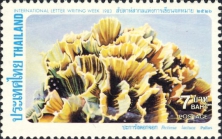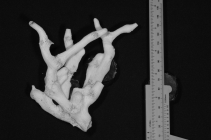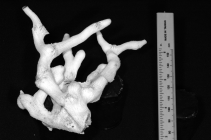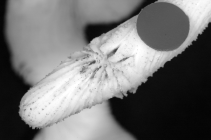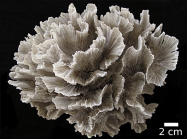
| About | | Search taxa | | Taxon tree | | Search literature | | Checklist | | Stats | | Log in |
WoRMS taxon detailsPectinia Blainville, 1825
205685 (urn:lsid:marinespecies.org:taxname:205685)
accepted
Genus
Madrepora lactuca Pallas, 1766 accepted as Pectinia lactuca (Pallas, 1766) (type by subsequent designation)
Madrepora (Tridacophyllia) Blainville, 1830 · unaccepted > junior subjective synonym
Parapectinia Nemenzo & Montecillo, 1981 · unaccepted > junior subjective synonym
Pectinia Oken, 1815 · unaccepted > unavailable name
Pectinia (Parapectinia) Nemenzo & Montecillo, 1981 · unaccepted > junior subjective synonym
Tridacnophyllia Blainville, 1830 · unaccepted > misspelling - incorrect subsequent spelling
Tridacophyllia Blainville, 1830 · unaccepted > junior subjective synonym
marine,
Blainville, H. M.; De. (1825). Mollusques, vers et zoophytes. <em>Dictionnaire des sciences naturelles.</em> 38: 1-528., available online at https://www.biodiversitylibrary.org/page/25302418 [details]
Oken, L. (1815-1816). Lehrbuch der Naturgeschichte. Dritter Theil: Zoologie. <em>Erste Abtheilung: Fleischlose Thiere,Leipzig: C.H. Reclam & Jena: A. Schmid, [book (3rd vol part one, of 3 vols, including plates atlas of T.1, 1813].</em> xxviii + 842 pp. + xviii, 40 pls. L [copepods 180-184, 357-359, 4 plates]., available online at https://doi.org/10.5962/bhl.title.166403 [details]
Description 'Polypier formé de feuilles minces, plus ou moins roulées, avec des étoiles des deux côtés, et il y place à peu près...
Description 'Polypier formé de feuilles minces, plus ou moins roulées, avec des étoiles des deux côtés, et il y place à peu près les mêmes espèces.' (de Blainville, 1825: 201) [details] Description Colonies are laminar to sub-arborescent, covered with high, thin, acute irregular walls usually arranged as short wide...
Description Colonies are laminar to sub-arborescent, covered with high, thin, acute irregular walls usually arranged as short wide valleys. Valleys may be as short as they are wide and the walls may form tall spires, becoming sub-arborescent. Corallite centres occur in any position. Septo-costae are well developed and may form the start of walls or spires. Polyps are extended only at night and then only rarely. (Veron, 1986 <57>) [details] Status Pectinia was originally described by Oken (1815). According to ICZN Opinion 417 (September 1956), the names originally...
Status Pectinia was originally described by Oken (1815). According to ICZN Opinion 417 (September 1956), the names originally proposed by Oken (1815) are rejected. Therefore authorship is assigned to the second person who used the name. [details]
Hoeksema, B. W.; Cairns, S. (2025). World List of Scleractinia. Pectinia Blainville, 1825. Accessed through: World Register of Marine Species at: https://www.marinespecies.org/aphia.php?p=taxdetails&id=205685 on 2025-06-01
Date action by
Nomenclatureoriginal description
Blainville, H. M.; De. (1825). Mollusques, vers et zoophytes. <em>Dictionnaire des sciences naturelles.</em> 38: 1-528., available online at https://www.biodiversitylibrary.org/page/25302418 [details] original description (of Tridacophyllia Blainville, 1830) de Blainville, H. M. (1830). Zoophytes. In: Dictionnaire des sciences naturelles, dans lequel on traitre méthodiquement des differéns êtres de la nature, considérés soit en eux-mêmes, d'après l'état actuel de nos connoissances, soit relativement à l'utlité qu'en peuvent retirer la médicine, l'agriculture, le commerce et les arts. Edited by F. G. Levrault. Tome 60. Paris, Le Normat. Pp. 548, pls. 68. <em>Paris, 1830.</em> 60 : 1-546., available online at https://www.biodiversitylibrary.org/page/25318344 [details] original description (of Pectinia (Parapectinia) Nemenzo & Montecillo, 1981) Nemenzo F, Montecillo E (1981) Four new Scleractinia species from Arangas Islet (Surigao del Sur Province, Philippines). The Philippine Scientist 22: 157-167. [details] original description (of Pectinia Oken, 1815) Oken, L. (1815-1816). Lehrbuch der Naturgeschichte. Dritter Theil: Zoologie. <em>Erste Abtheilung: Fleischlose Thiere,Leipzig: C.H. Reclam & Jena: A. Schmid, [book (3rd vol part one, of 3 vols, including plates atlas of T.1, 1813].</em> xxviii + 842 pp. + xviii, 40 pls. L [copepods 180-184, 357-359, 4 plates]., available online at https://doi.org/10.5962/bhl.title.166403 [details] basis of record Veron JEN. (1986). Corals of Australia and the Indo-Pacific. <em>Angus & Robertson Publishers.</em> [details] original description (unavailable nomenclaturally) Oken, L. (1815-1816). Lehrbuch der Naturgeschichte. Dritter Theil: Zoologie. <em>Erste Abtheilung: Fleischlose Thiere,Leipzig: C.H. Reclam & Jena: A. Schmid, [book (3rd vol part one, of 3 vols, including plates atlas of T.1, 1813].</em> xxviii + 842 pp. + xviii, 40 pls. L [copepods 180-184, 357-359, 4 plates]., available online at https://doi.org/10.5962/bhl.title.166403 [details] Otheradditional source
Duncan PM (1884) A revision of the families and genera of the sclerodermic Zoantharia, Ed. & H., or Madreporaria (M. Rugosa excepted). Journal of the Linnean Society of London, 18: 1-204. [details]
additional source Dunn, D. F. (1982). Cnidaria. McGraw-Hill Book Company. New York and other cities., volume 1, pp. 669-706 page(s): 702 [details] additional source Veron JEN. (2000). Corals of the World. Vol. 1–3. <em>Australian Institute of Marine Science and CRR, Queensland, Australia.</em> [details] additional source Wells JW. (1936). The nomenclature and type species of some genera of recent and fossil corals. <em>American Journal of Science.</em> 31: 97-134., available online at https://ajsonline.org/article/61464 [details] additional source Budd AF, Fukami H, Smith ND, Knowlton N. (2012). Taxonomic classification of the reef coral family Mussidae (Cnidaria: Anthozoa: Scleractinia). <em>Zoological Journal of the Linnean Society.</em> 166 (3): 465-529., available online at https://doi.org/10.1111/j.1096-3642.2012.00855.x [details] additional source Matthai G. (1928). A Monograph of the Recent meandroid Astraeidae. <em>Catalogue of the Madreporarian Corals in the British Museum (Natural History).</em> 7: 1-288, pls. 1-72. [details] Available for editors  Present Present  Inaccurate Inaccurate  Introduced: alien Introduced: alien  Containing type locality Containing type locality
From editor or global species database
Comparison Pectinia and Mycedium share all morphological traits examined here, resulting in a polytomy on the phylogeny. Physophyllia also scored identically for macromorphology. There are thus no apomorphies yet for Pectinia, but its members generally have thin and acute laminae that project upward, lacking the large rounded vesicular ridges separating adjacent calices and inclined corallites as seen in Physophyllia and Mycedium respectively. Synapomorphies for the well-supported Pectinia + Mycedium clade include organically united and polymorphic corallites, extensive coenosteum (≥ corallite diameter), unequal costosepta thickness, discontinuous columellae (lamellar linkage), ≤ 6 teeth per septum, interarea made up of horizontal bands, and presence of micro-fibrous deposits. Note that quantitative measurements were made on peripheral corallites; structures of the central corallite are not indicative of the main parts of the colony. [details]Description 'Polypier formé de feuilles minces, plus ou moins roulées, avec des étoiles des deux côtés, et il y place à peu près les mêmes espèces.' (de Blainville, 1825: 201) [details] Description Colonies are laminar to sub-arborescent, covered with high, thin, acute irregular walls usually arranged as short wide valleys. Valleys may be as short as they are wide and the walls may form tall spires, becoming sub-arborescent. Corallite centres occur in any position. Septo-costae are well developed and may form the start of walls or spires. Polyps are extended only at night and then only rarely. (Veron, 1986 <57>) [details] Diagnosis Colonial, with intracalicular budding only. Corallites polymorphic and organically united; monticules absent. Coenosteum costate, extensive amount (≥ corallite diameter). Calice width medium (4–15 mm), with medium relief (3–6 mm). Costosepta confluent. Septa in 3 cycles (24–36 septa). Free septa present but irregular. Septa spaced < 6 septa per 5 mm. Costosepta unequal in relative thickness. Columellae trabecular and spongy (> 3 threads), < 1/4 of calice width, and discontinuous among adjacent corallites (lamellar linkage). Paliform (uniaxial) lobes weak or moderate. Epitheca absent and endotheca abundant (vesicular). Tooth base at mid-calice circular. Tooth tip at mid-calice irregular; tip orientation perpendicular to septum. Tooth height medium (0.3–0.6 mm) and tooth spacing medium (0.3–1 mm), with no more than 6 teeth per septum. Granules scattered on septal face; irregular in shape. Interarea formed by horizontal bands. Walls formed by dominant paratheca; abortive septa absent. Thickening deposits micro-fibrous. Costa center clusters not distinct; medial lines strong. Septum center clusters not distinct; medial lines strong. Transverse crosses absent. Columella centers clustered. [details] Remark It is the type genus of Pectiniidae Vaughan and Wells, 1943: 196, which also contains Echinophyllia, Mycedium, Oxypora, and Physophyllia, among the living scleractinians. Recent broad-scale molecular phylogenetic studies have placed the clade Echinophyllia + Oxypora within Lobophylliidae, while Pectinia and Mycedium form a monophyletic group in Merulinidae (Fukami et al., 2004, 2008; Arrigoni et al. 2012). Physophyllia is expected to be a close relative of Pectinia based on macromorphology (see remarks for Physophyllia below). Pectinia is often associated with Oulophyllia (e.g. Veron, 2000, vol. 2: 348), the latter being described as having comparatively lower walls and more spongy columellae (Milne Edwards and Haime, 1848, vol. 27: 492). As noted above, laminae of the former are probably not homologous to the walls of Oulophyllia, but the two genera are indeed closely related, and together with Caulastraea and Mycedium form a well-supported molecular clade (Fukami et al., 2008; Huang et al., 2011; Arrigoni et al., 2012). [details] Status Pectinia was originally described by Oken (1815). According to ICZN Opinion 417 (September 1956), the names originally proposed by Oken (1815) are rejected. Therefore authorship is assigned to the second person who used the name. [details] Type designation Subsequent designation by Vaughan (1918) [details]
|
